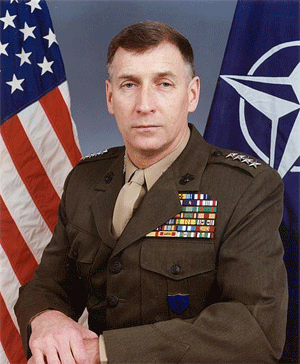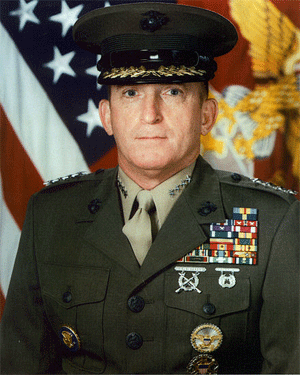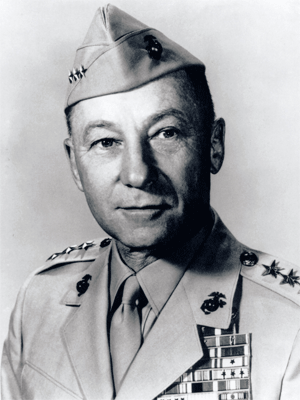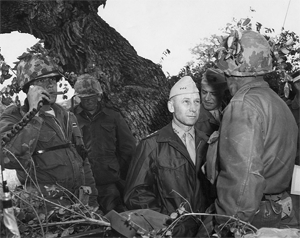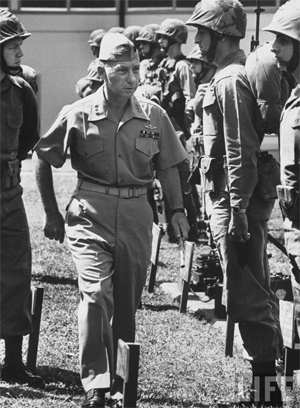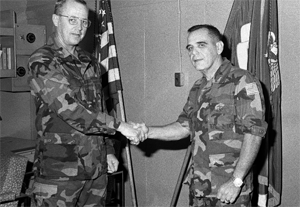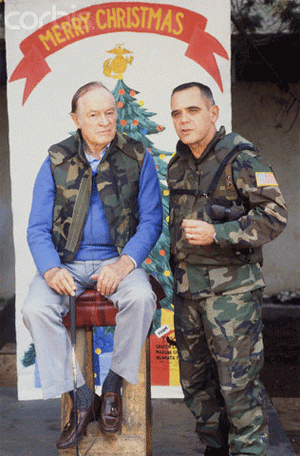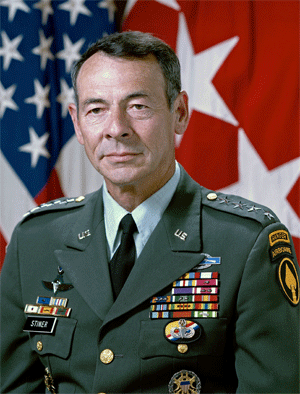Part 1 of 3
Waco siegeby Wikipedia
Accessed: 3/31/18
NOTICE: THIS WORK MAY BE PROTECTED BY COPYRIGHTYOU ARE REQUIRED TO READ
THE COPYRIGHT NOTICE AT THIS LINK BEFORE YOU READ THE FOLLOWING WORK, THAT IS AVAILABLE SOLELY FOR PRIVATE STUDY, SCHOLARSHIP OR RESEARCH PURSUANT TO 17 U.S.C. SECTION 107 AND 108. IN THE EVENT THAT THE LIBRARY DETERMINES THAT UNLAWFUL COPYING OF THIS WORK HAS OCCURRED, THE LIBRARY HAS THE RIGHT TO BLOCK THE I.P. ADDRESS AT WHICH THE UNLAWFUL COPYING APPEARED TO HAVE OCCURRED. THANK YOU FOR RESPECTING THE RIGHTS OF COPYRIGHT OWNERS.
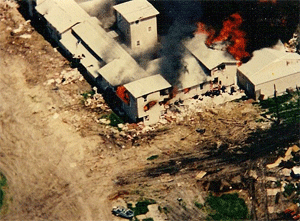
Waco siege
The Mount Carmel Center engulfed in flames on April 19, 1993
Date February 28 – April 19, 1993; 24 years ago
Location Mount Carmel Center, near Waco, Texas, U.S.
31°35′45″N 96°59′17″WCoordinates: 31°35′45″N 96°59′17″W
Caused by Suspected weapons violations[1]
Goals
ATF attempted to serve search and arrest warrants.
FBI attempted to end ensuing siege.
Resulted in
Four ATF agents and six Branch Davidians killed in initial raid.
A 51-day siege ensued, ending with an FBI assault during which the compound burned down, killing 76 people inside including David Koresh. Eleven people who left the compound were arrested.[2]
Parties to the civil conflict
United States United States
ATF
FBI
Branch Davidians
Unknown number of armed adult members of the Branch Davidian home and church (maximum residents during siege 132)
Lead figures
Janet Reno
Jeff Jamar
Richard Rogers
David Koresh
Steven Schneider
Wayne Martin[3]
Number
ATF and FBI: Hundreds of agents.
80+ Branch Davidians.
Casualties
4 ATF agents killed, 16 wounded.
6 killed on February 28.
76 killed on April 19.
Total: 82 killed
Mount Carmel Center is located in Texas Mount Carmel CenterMount Carmel Center
The Waco siege was the siege of a compound belonging to the Branch Davidians, carried out by American federal and Texas state law enforcement, as well as the U.S. military, between February 28 and April 19, 1993.[4] The Branch Davidians, was led by David Koresh and was headquartered at Mount Carmel Center ranch in the community of Axtell, Texas,[5][6][7] 13 miles (21 kilometers) east-northeast of Waco. Suspecting the group of stockpiling illegal weapons, the ATF obtained a search warrant for the compound and arrest warrants for Koresh and a select few of the group's members.
The incident began when the ATF attempted to raid the ranch. An intense gun battle erupted, resulting in the deaths of four government agents and six Branch Davidians. Upon the ATF's failure to raid the compound, a siege lasting 51 days was initiated by the Federal Bureau of Investigation (FBI). Eventually, the FBI launched an assault and initiated a tear gas attack in an attempt to force the Branch Davidians out of the ranch. During the attack, a fire engulfed Mount Carmel Center. In total, 76 people died,[8][9] including David Koresh.
Much dispute remains as to the actual events of the siege. A particular controversy ensued over the origin of the fire; an internal Justice Department investigation concluded in 2000 that sect members had started the fire. The events near Waco, and the siege at Ruby Ridge less than twelve months earlier, were both cited as the primary motivations behind the Oklahoma City bombing that took place exactly two years later.
BackgroundThe Branch Davidians (also known as "The Branch") is a religious group that originated in 1955 from a schism in Shepherd's Rod (Davidians) following the death of the Shepherd's Rod founder Victor Houteff. Houteff founded the Davidians based on his prophecy of an imminent apocalypse involving the Second Coming of Jesus Christ and the defeat of the evil armies of "Babylon".[10] As the original Davidian group gained members, its leadership moved the church to a hilltop several miles east of Waco, Texas, which they named Mount Carmel, after a mountain in Israel mentioned in Joshua 19:26 in the Bible's Old Testament. A few years later, they moved again to a much larger site east of the city. In 1959, the widow of Victor Houteff, Florence Houteff, announced that the expected Armageddon was about to take place, and members were told to gather at the center to await this event. Many built houses, others stayed in tents, trucks, or buses, and most sold their possessions.[11]
Following the failure of this prophecy, which many attribute to Mrs. Houteff setting her own private date as to its fulfillment, control of the site (Mount Carmel Center) fell to Benjamin Roden, founder of the Branch Davidian Seventh-day Adventist Association (Branch Davidians). He promoted different doctrinal beliefs than Victor Houteff's original Davidian Seventh-day Adventist organization. On Roden's death, control fell to his wife, Lois Roden. Lois considered their son, George Roden, unfit to assume the position of prophet. Instead, she groomed Vernon Howell (later known as David Koresh) as her chosen successor. In 1984, a meeting led to a division of the group, with Howell leading one faction (calling themselves the Davidian Branch Davidians) and George Roden leading the competing faction. After this split, George Roden ran Howell and his followers off Mount Carmel. Howell and his group relocated to Palestine, Texas.[12][13]
After the death of Lois Roden and probate of her estate in January 1987, Howell attempted to gain control of Mount Carmel Center by force. George Roden had dug up the casket of Anna Hughes from the Davidian cemetery and had challenged Howell to a resurrection contest to prove who was the rightful heir to the leadership. Howell instead went to the police and claimed Roden was guilty of corpse abuse, but the county prosecutors refused to file charges without proof. On November 3, 1987, Howell and seven armed companions attempted to access the Mount Carmel chapel, with the goal of photographing the body in the casket as evidence to incriminate Roden. Roden was advised of the interlopers and grabbed an Uzi in response. The Sheriff's Department responded about 20 minutes into the gunfight, during which Roden was wounded. Sheriff Harwell got Howell on the phone and told him to stop shooting and surrender. Howell and his companions, dubbed the "Rodenville Eight" by the media, were tried for attempted murder on April 12, 1988; seven were acquitted, and the jury was hung on Howell's verdict. The county prosecutors did not press the case further.[14]
While waiting for the trial, Roden was put in jail under contempt of court charges because of his use of foul language in some court pleadings, threatening the Texas court with sexually transmitted diseases if the court ruled in favor of Howell. The next day, Perry Jones and a number of Howell's other followers moved from their headquarters in Palestine, Texas, to Mount Carmel. In mid-1989, Roden used an axe to kill a Davidian named Wayman Dale Adair, who visited him to discuss Adair's vision of being God's chosen messiah. He was found guilty under an insanity defense and was committed to a mental hospital. Shortly after Roden's commitment, Howell raised money to pay off all the back taxes on Mount Carmel owed by Roden and took legal control of the property.[15]
On August 5, 1989, Howell released the "New Light" audio tape, in which he stated he had been told by God to procreate with the women in the group to establish a "House of David" of his "special people". This involved separating married couples in the group and agreeing that only he could have sexual relations with the wives, while the men should observe celibacy.[15][16] He also claimed that God had told him to start building an "Army for God" to prepare for the end of days and a salvation for his followers.[16] Howell filed a petition in the California State Superior Court in Pomona on May 15, 1990, to legally change his name "for publicity and business purposes" to David Koresh; on August 28, he was granted the petition.[17] By 1992, most of the land belonging to the group had been sold except for a core 77 acres (31 ha). Most of the buildings had been removed or were being salvaged for construction materials to convert much of the main chapel and a tall water tank into apartments for the resident members of the group. Many of the members of the group had been involved with the Davidians for a few generations, and many had large families.[18]
PreludeIf you are a Branch Davidian, Christ lives on a threadbare piece of land 10 miles [16 km] east of here called Mount Carmel. He has dimples, claims a ninth-grade education, married his legal wife when she was 14, enjoys a beer now and then, plays a mean guitar, reportedly packs a 9 mm Glock and keeps an arsenal of military assault rifles, and willingly admits that he is a sinner without equal.
— Opening passage of "The Sinful Messiah", Waco Tribune-Herald, February 27, 1993[19]
On February 27, 1993, the Waco Tribune-Herald began publishing "The Sinful Messiah", a series of articles by Mark England and Darlene McCormick, who reported allegations that Koresh had physically abused children in the compound and had committed statutory rape by taking multiple underage brides. Koresh was also said to advocate polygamy for himself and declared himself married to several female residents of the small community. According to the paper, Koresh declared he was entitled to at least 140 wives, that he was entitled to claim any of the females in the group as his, that he had fathered at least a dozen children, and that some of these mothers became brides as young as 12 or 13 years old.[19]
In addition to allegations of sexual abuse and misconduct, Koresh and his followers were suspected of stockpiling illegal weapons. In May 1992, Chief Deputy Daniel Weyenberg of the McLennan County Sheriff's Department called the Bureau of Alcohol, Tobacco and Firearms (ATF) to notify them that his office had been contacted by a local UPS representative. A UPS driver described a package that had broken open on delivery to the Branch Davidian residence, revealing firearms, inert grenade casings, and black powder. On June 9, a formal investigation was opened and a week later it was classified as sensitive, "thereby calling for a high degree of oversight" from both Houston and headquarters.[20][21] The documentary Inside Waco claims that the investigation started when in 1992 the ATF became concerned over reports of automatic gunfire coming from the Carmel compound.[22] On July 30, ATF agents David Aguilera and Skinner visited the Branch Davidians' gun dealer Henry McMahon, who tried to get them to talk with Koresh on the phone. Koresh offered to let ATF inspect the Branch Davidians' weapons and paperwork and asked to speak with Aguilera, but Aguilera declined.[23][24] Sheriff Harwell told reporters regarding law enforcement talking with Koresh, "Just go out and talk to them, what's wrong with notifying them?"[25] The ATF began surveillance from a house across the road from the compound several months before the siege. Their cover was noticeably poor (the "college students" were in their 30s, had new cars, were not registered at the local schools, and did not keep a schedule which would have fit any legitimate employment or classes).[26] The investigation included sending in an undercover agent, Robert Rodriguez, whose identity Koresh learned, though he chose not to reveal that fact until the day of the raid.
The ATF obtained a search warrant on suspicion that the Davidians were modifying guns to have illegal automatic fire capability. Former Branch Davidian Marc Breault claimed that Koresh had "M16 lower receiver parts"[15] (combining M16 trigger components with a modified AR-15 lower receiver is, according to ATF regulations, "constructive possession" of an unregistered machine gun, regulated in the Firearm Owners Protection Act of 1986[27]).
Raid
PreparationsUsing the affidavit filed by Aguilera that alleged that the Davidians had violated federal law, the ATF obtained search and arrest warrants for Koresh and specific followers on weapons charges, citing the many firearms they had accumulated.[28][29] The search warrant commanded a search "on or before February 28, 1993", in the daytime between 6:00 am and 10:00 pm. ATF made a claim that Koresh was possibly operating a methamphetamine lab, to establish a drug nexus and obtain military assets under the War on Drugs. Although the ATF's investigation "focused on firearm violations, not on illegal drugs", the ATF requested assistance from the DEA and the DOD "citing a drug connection" based on 1) a recent delivery to the compound of "chemicals, instruments, and glassware", 2) a written testimony from a former compound's resident, alleging "Howell had told him that drug trafficking was a desirable way to raise money", 3) several current residents who "had prior drug involvement", 4) two former residents who were incarcerated for drug-trafficking crimes, and 5) National Guard overflights' thermal images showing a "hot spot inside the compound, possibly indicating a methamphetamine laboratory".[30] Although the original request for assistance was initially approved, the commander of the Special Forces detachment questioned the request, and the ATF obtained only a training site at Fort Hood, Texas, from February 25 to February 27 with safety inspections for the training lanes, and was given only medical and communications training and equipment.[31]
ATF had planned their raid for Monday, March 1, 1993, with the code name "Showtime".[32] The ATF later claimed that the raid was moved up a day, to February 28, 1993, in response to the Waco Tribune-Herald's "The Sinful Messiah" series of articles (which the ATF had tried to prevent from being published).[22] Beginning February 1, ATF agents had three meetings with Tribune-Herald staff regarding a delay in publication of "The Sinful Messiah". The paper was first told by ATF that the raid would take place February 22, which they changed to March 1, and then ultimately to an indefinite date. ATF agents felt the newspaper had held off publication at the request of the ATF for at least three weeks. In a February 24 meeting between Tribune-Herald staff and ATF agent Phillip Chojancki and two other agents, ATF could not give the newspaper staff a clear idea of what action was planned or when. The Tribune-Herald informed ATF they were publishing the series, which included an editorial calling for local authorities to act. Personnel of the Tribune-Herald found out about the imminent raid after the first installment of "The Sinful Messiah" had already appeared on February 27.[33]
Although the ATF preferred to arrest Koresh when he was outside Mount Carmel, planners received inaccurate information that Koresh rarely left it.[34] The Branch Davidian members were well known locally and had cordial relations with other locals. The Branch Davidians partly supported themselves by trading at gun shows and took care to have the relevant paperwork to ensure their transactions were legal.[35] Branch Davidian Paul Fatta was a federal firearms licensed dealer, and the group operated a retail gun business called the Mag Bag. When shipments for the Mag Bag arrived, they were signed for by Fatta, Steve Schneider, or Koresh. The morning of the raid, Paul Fatta and son Kalani were on their way to an Austin, Texas, gun show to conduct business.[36]
February 28The ATF attempted to execute their search warrant on Sunday morning, February 28, 1993. Any advantage of surprise was lost when a KWTX-TV reporter who had been tipped off about the raid asked for directions from a U.S. Postal Service mail carrier who was coincidentally Koresh's brother-in-law.[22] Koresh then told undercover ATF agent Robert Rodriguez that they knew a raid was imminent. Rodriguez had infiltrated the Branch Davidians and was astonished to find that his cover had been blown. The agent made an excuse and left the compound. When asked later what the Branch Davidians had been doing when he left the compound, Rodriguez replied, "They were praying." Branch Davidian survivors have written that Koresh ordered selected male followers to begin arming and taking up defensive positions, while the women and children were told to take cover in their rooms.[22] Koresh told them he would try to speak to the agents, and what happened next would depend on the agents' intentions.
Despite being informed that the Branch Davidians knew a raid was coming, the ATF commander ordered that the raid go ahead, even though their plan depended on reaching the compound without the Branch Davidians being armed and prepared.[22] While not standard procedure, ATF agents had their blood type written on their arms or neck after leaving the staging area and before the raid, because it was recommended by the military to facilitate speedy blood transfusions in the case of injury.[37][38]
ATF agents stated that they heard shots coming from within the compound, while Branch Davidian survivors claimed that the first shots came from the ATF agents outside. A suggested reason may have been an accidental discharge of a weapon, possibly by an ATF agent, causing the ATF to respond with fire from automatic weapons.[35] Other reports claim the first shots were fired by the ATF "dog team" sent to kill the dogs in the Branch Davidian kennel.[39] Three Army National Guard helicopters were used as aerial distraction, and all took incoming fire but did not return fire.[40] During the first shots, Koresh was wounded, shot in the wrist.[41] Within a minute of the raid starting, Branch Davidian Wayne Martin called emergency services, pleading for them to stop shooting.[41] The resident asked for a ceasefire, and audiotapes record him saying, "Here they come again!" and, "That's them shooting! That's not us!"[41]
The first ATF casualty was an agent who had made it to the west side of the building before he was wounded. Agents quickly took cover and fired at the buildings while the helicopters began their diversion and swept in low over the complex, 350 feet (105 m) away from the building.[40] The Branch Davidians fired on the helicopters and hit them, without injuring the crew, and the helicopters immediately stopped the mission and landed.[40] On the east side of the compound, agents hauled out two ladders and set them against the side of the building. Agents then climbed onto the roof with the objective of securing the roof to reach Koresh's room and the arms storage. On the west slope of the roof, three agents reached Koresh's window and were crouching beside it when they came under fire. One agent was killed and another wounded. The third agent scampered over the peak of the roof and joined other agents attempting to enter the arms room. The window was smashed, a flashbang stun grenade thrown in, and three agents entered the arms room. When another tried to follow them, a hail of bullets penetrated the wall and wounded him, but he was able to reach a ladder and slide to safety. An agent fired with his shotgun at Branch Davidians who were shooting at him until he was hit in the head and killed. Inside the arms room, the agents killed a Branch Davidian gunman and discovered a cache of weapons but then came under heavy fire; two were wounded. As they escaped, the third agent laid down covering fire, killing a Branch Davidian. As he made his escape, he hit his head on a wooden support beam and fell off the roof but survived. An agent outside provided them with covering fire but was shot by a Branch Davidian and killed instantly. Dozens of ATF agents took cover, many behind Branch Davidian vehicles, and exchanged fire with the Branch Davidians. The number of ATF wounded increased, and an agent was killed by gunfire from the compound as agents were firing at a Branch Davidian perched on top of the water tower. The exchange of fire continued, but 45 minutes into the raid the gunfire began to slow down as agents began to run low on ammunition. The shooting continued for two hours.[42]
Sheriff Lt. Lynch of the McLennan County Sheriff Department contacted the ATF and negotiated a ceasefire.[22] Sheriff Harwell states in William Gazecki's documentary Waco: The Rules of Engagement that the ATF agents withdrew only after they were out of ammunition.[43] ATF agent Chuck Hustmyre later wrote: "About 45 minutes into the shootout, the volume of gunfire finally started to slacken. We were running out of ammunition. The Davidians, however, had plenty." After the ceasefire, the Branch Davidians allowed the ATF dead and wounded to be evacuated and held their fire during the ATF retreat.
Four ATF agents (Steve Willis, Robert Williams, Todd McKeehan, and Conway Charles LeBleu) were killed during the raid. Another 16 were wounded. The five Branch Davidians killed in the 9:45 am raid were Winston Blake, Peter Gent, Peter Hipsman, Perry Jones, and Jaydean Wendell; two were killed at the hands of the Branch Davidians.[44] Nearly six hours after the 11:30 am ceasefire, Michael Schroeder was shot dead by ATF agents who alleged he fired a pistol at agents as he attempted to re-enter the compound with Woodrow Kendrick and Norman Allison.[22] The local sheriff, in audiotapes broadcast after the incident, said he was not apprised of the raid. Alan A. Stone's report states that the Branch Davidians did not ambush the ATF and that they "apparently did not maximize the kill of ATF agents", explaining that they were rather "desperate religious fanatics expecting an apocalyptic ending, in which they were destined to die defending their sacred ground and destined to achieve salvation."[45] A 1999 federal report noted:
The violent tendencies of dangerous cults can be classified into two general categories——defensive violence and offensive violence. Defensive violence is utilized by cults to defend a compound or enclave that was created specifically to eliminate most contact with the dominant culture. The 1993 clash in Waco, Texas at the Branch Davidian complex is an illustration of such defensive violence. History has shown that groups that seek to withdraw from the dominant culture seldom act on their beliefs that the endtime has come unless provoked.[46]
Chronology of events on February 28Time / Event
05:00 / 76 agents assemble at Fort Hood for the drive to the staging area at the Bellmead Civic Center. According to a later Treasury Department Review, the agents drove in an 80-vehicle convoy that stretched for a mile (1.6 km) with a cattle trailer at either end.
09:45 / ATF agents move in on the compound. A gun battle begins.
09:48 / Branch Davidian Wayne Martin, a Waco attorney, calls 9-1-1.
11:30 / Ceasefire reached.
16:00 / The first message from Koresh is relayed over KRLD Radio In Dallas.
16:55 / Michael Schroeder is shot dead returning to the compound.
17:00 / ATF spokesman Ted Royster says gunfire has continued sporadically through the afternoon.
19:30 / Koresh is interviewed by CNN. The FBI instructs CNN not to conduct further interviews.
20:15 / ATF spokesperson Sharon Wheeler says negotiations continue with Branch Davidians and gunfire has ended.
22:00 / Four children exited the compound (two Sonobe children and two Fagan children).
22:05 / Koresh talks for about 20 minutes on KRLD, describing his beliefs and saying he is the most seriously wounded of the Branch Davidians.
SiegeATF agents established contact with Koresh and others inside the compound after they withdrew. The FBI took command soon after as a result of the deaths of federal agents, placing Jeff Jamar, head of the Bureau's San Antonio field office, in charge of the siege as Site Commander. The FBI Hostage Rescue Team (HRT) was headed by HRT Commander Richard Rogers, who had previously been criticized for his actions during the Ruby Ridge incident. As at Ruby Ridge, Rogers often overrode the Site Commander at Waco and had mobilized both the Blue and Gold HRT tactical teams to the same site, which ultimately created pressure to resolve the situation tactically due to lack of HRT reserves.
At first, the Davidians had telephone contact with local news media, and Koresh gave phone interviews. The FBI cut Davidian communication to the outside world. For the next 51 days, communication with those inside was by telephone by a group of 25 FBI negotiators.[22] The final Justice Department report found that negotiators criticized the tactical commanders for undercutting negotiations.[47]
In the first few days, the FBI believed they had made a breakthrough when they negotiated with Koresh an agreement that the Branch Davidians would peacefully leave the compound in return for a message, recorded by Koresh, being broadcast on national radio.[22] The broadcast was made, but Koresh then told negotiators that God had told him to remain in the building and "wait".[22] Despite this, soon afterwards negotiators managed to facilitate the release of 19 children, ranging in age from five months to 12 years old, without their parents.[11] However, 98 people remained in the building.[22] The children were then interviewed by the FBI and Texas Rangers, some for hours at a time.[11] Allegedly, the children had been physically and sexually abused long before the standoff.[48] This was the key justification offered by the FBI (both to President Bill Clinton and to Attorney General Janet Reno) for launching tear gas attacks to force the Branch Davidians out of the compound.[49]
During the siege, the FBI sent a video camera to the Branch Davidians. In the video tape made by Koresh's followers, Koresh introduced his children and his "wives" to the FBI negotiators, including several minors who claimed to have had babies fathered by Koresh. (Koresh had fathered perhaps 14 of the children who stayed with him in the compound.) Several Branch Davidians made statements in the video.[50] On day nine, Monday March 8, the Branch Davidians sent out the video tape to show the FBI that there were no hostages, but in fact everyone was staying inside of their own free will. This video also included a message from Koresh.[22] The negotiators' log showed that—when the tape was reviewed—there was concern that the tape's release to the media would gain sympathy for Koresh and the Branch Davidians.[51] Videos also showed the 23 children still inside the compound, and child care professionals on the outside prepared to take care of those children as well as the previous 21 released.[11] As the siege continued, Koresh negotiated more time, allegedly so that he could write religious documents which he said he needed to complete before he surrendered. His conversations—dense with Biblical imagery—alienated the federal negotiators, who treated the situation as a hostage crisis.
As the siege wore on, two factions developed within the FBI,[22] one believing negotiation to be the answer, the other, force. Increasingly aggressive techniques were used to try to force the Branch Davidians out (for instance, sleep deprivation of the inhabitants by means of all-night broadcasts of recordings of jet planes, pop music, chanting, and the screams of rabbits being slaughtered). Outside the compound, nine Bradley Fighting Vehicles (carrying M651 CS tear gas grenades and Ferret rounds) and five M728 Combat Engineer Vehicles (obtained from the U.S. Army) began patrolling.[22] The armored vehicles were used to destroy perimeter fencing and outbuildings and crush cars belonging to the Branch Davidians. Armored vehicles repeatedly drove over the grave of Branch Davidian Peter Gent despite protests by the Branch Davidians and the negotiators. Two of the three water storage tanks on the roof of the main building had been damaged during the initial ATF raid. Eventually the FBI cut all power and water to the compound, forcing those inside to survive on rain water and stockpiled military MRE rations.[22] Criticism was later leveled by Schneider's attorney, Jack Zimmerman, at the tactic of using sleep-and-peace-disrupting sound against the Branch Davidians: "The point was this – they were trying to have sleep disturbance and they were trying to take someone that they viewed as unstable to start with, and they were trying to drive him crazy. And then they got mad 'cos he does something that they think is irrational!"[52]
Despite the increasingly aggressive tactics, Koresh ordered a group of followers to leave. Eleven people left and were arrested as material witnesses, with one person charged with conspiracy to murder.[22] The children's willingness to stay with Koresh disturbed the negotiators, who were unprepared to work around the Branch Davidians' religious zeal. However, as the siege went on, the children were aware that an earlier group of children who had left with some women were immediately separated, and the women arrested. During the siege, a number of scholars who study apocalypticism in religious groups attempted to persuade the FBI that the siege tactics being used by government agents would only reinforce the impression within the Branch Davidians that they were part of a Biblical "end-of-times" confrontation that had cosmic significance.[53] This would likely increase the chances of a violent and deadly outcome. The religious scholars pointed out that the beliefs of the group may have appeared to be extreme, but to the Branch Davidians, their religious beliefs were deeply meaningful, and they were willing to die for them.[53]
Koresh's discussions with the negotiating team became increasingly difficult. He proclaimed that he was the Second Coming of Christ and had been commanded by his father in heaven to remain in the compound.[22] One week prior to the April 19 assault, FBI planners considered using snipers to kill David Koresh and possibly other key Branch Davidians.[54] The FBI voiced concern that the Branch Davidians might commit mass suicide, as had happened in 1978 at Jim Jones's Jonestown complex. Koresh had repeatedly denied any plans for mass suicide when confronted by negotiators during the standoff, and people leaving the compound had not seen any such preparation.[55]
Final assault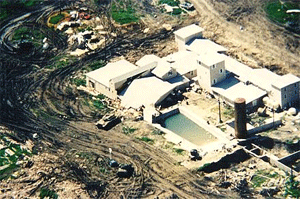 An M728 Combat Engineer Vehicle brings down the back wall and roof of the Mount Carmel gymnasium
An M728 Combat Engineer Vehicle brings down the back wall and roof of the Mount Carmel gymnasium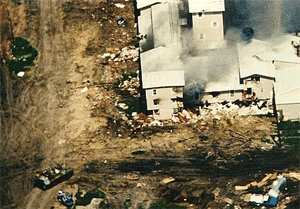 Smoke rises from the compound
Smoke rises from the compound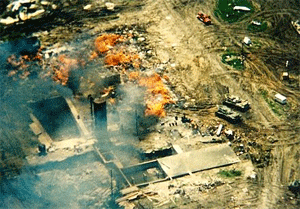 Last remnants of the razed Mount Carmel Center burn down
Last remnants of the razed Mount Carmel Center burn downNewly appointed U.S. Attorney General Janet Reno approved recommendations by the FBI Hostage Rescue Team to mount an assault, after being told that conditions were deteriorating and that children were being abused inside the compound.[48] Reno made the FBI's case to President Bill Clinton. Recalling the April 19, 1985, The Covenant, The Sword, and the Arm of the Lord (CSAL) siege in Arkansas (which was ended without loss of life by a blockade without a deadline), President Clinton suggested similar tactics against the Branch Davidians. Reno countered that the FBI Hostage Rescue Team was tired of waiting; that the standoff was costing a million dollars per week; that the Branch Davidians could hold out longer than the CSAL; and that the chances of child sexual abuse and mass suicide were imminent. Clinton later recounted: "Finally, I told her that if she thought it was the right thing to do, she could go ahead."[56] Over the next several months, Janet Reno's reason for approving the final gas attack varied from her initial claim that the FBI Hostage Rescue Team had told her that Koresh was sexually abusing children and beating babies (the FBI Hostage Rescue Team later denied evidence of child abuse during the standoff) to her claim that Linda Thompson and her one-woman "Unorganized Militia of the United States" was on the way to Waco to aid or attack Koresh.[57]
Because the Branch Davidians were heavily armed, the FBI Hostage Rescue Team's arms included .50 caliber (12.7 mm) rifles and armored Combat Engineering Vehicles (CEV). The assault took place on April 19, 1993. CEVs used explosives to puncture holes in the walls of buildings of the compound so they could pump in CS gas ("tear gas") and try to flush out the Branch Davidians without harming them. The stated plan called for increasing amounts of gas to be pumped in over two days to increase pressure. Officially, no armed assault was to be made and loudspeakers were to be used to tell the Branch Davidians that there would be no armed assault and to ask them not to fire on the vehicles. FBI Hostage Rescue Team agents had been permitted to return any incoming fire, but no shots were fired by federal agents on April 19. When several Branch Davidians opened fire, the FBI Hostage Rescue Team's response was to increase the amount of gas being used.[22]
The FBI Hostage Rescue Team delivered 40-millimetre (1.6 in) CS grenade fire from M79 grenade launchers; very early in the morning, the FBI Hostage Rescue Team fired two military M651 rounds at the Branch Davidian construction site. Around mid-morning, the FBI Hostage Rescue Team began to run low on 40 mm Ferret CS rounds and asked Texas Ranger Captain David Byrnes for tear gas rounds; the tear gas rounds procured from Company "F" in Waco turned out to be unusable pyrotechnic rounds and were returned to the Company "F" office afterwards.[58] 40 mm munitions recovered by the Texas Rangers at Waco included dozens of plastic Ferret Model SGA-400 Liquid CS rounds, two metal M651E1 military pyrotechnic tear gas rounds, two metal NICO Pyrotechnik Sound & Flash grenades, and parachute illumination flares.[58][59] After more than six hours, no Branch Davidians had left the building, sheltering instead in a concrete block room within the building or using gas masks.[60] The FBI Hostage Rescue Team stated that CEVs were used to punch large holes in the building to provide exits for those inside.[citation needed]
At around noon, three fires broke out almost simultaneously in different parts of the building and spread quickly. The government maintains the fires were deliberately started by the Branch Davidians.[22][61] Some Branch Davidian survivors maintain that the fires were accidentally or deliberately started by the assault.[62][63] Only nine people left the building during the fire.[22][61] The remaining Branch Davidians, including the children, were either buried alive by rubble, suffocated by the effects of the fire, or shot. Many who suffocated from the fire were killed by smoke or carbon monoxide inhalation and other causes as fire engulfed the building.[61] According to the FBI, Steve Schneider—Koresh's top aide—shot and killed Koresh and then killed himself with the same gun.[64] Footage of the blaze was broadcast live by television crews.


